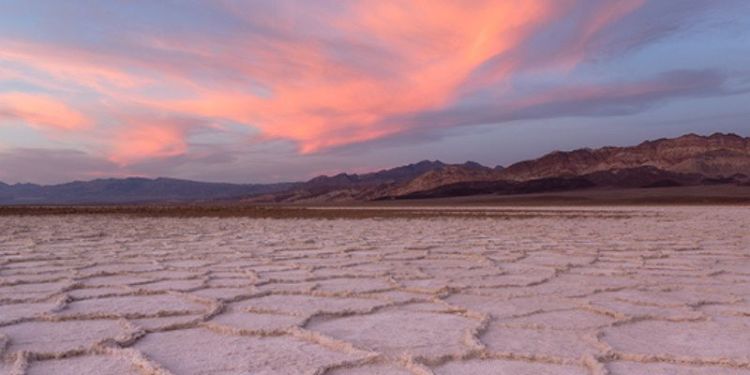Origins of mysterious patterns created by salt deserts

The curious landscapes formed by dried out salt lakes are caused by the movement of fluids in the soil beneath the surface, according to new research published today.
The curious landscapes formed by dried out salt lakes are caused by the movement of fluids in the soil beneath the surface, according to new research published today.
The characteristic honeycomb patterns are found worldwide, including in Death Valley in California where they attract tens of thousands of tourists. The enigmatic structures were also the inspiration for the planet Crait in ‘Star Wars: The Last Jedi.’
Until now, a mechanism to explain the origins of the patterns and their iconic shape and size has proved elusive. It was thought that the salt crust of the desert dries out and cracks form around which the patterns grow, but this did not account for their consistent size and shape.
Our findings provide vital insight into this incredible physical phenomenon.
A team of researchers including applied mathematicians from the University of Leeds, has now concluded that these beautiful landscapes may form as a result of the convection of saltwater in the subsurface.
The results of their study which was supported by the Natural Environment Research Council, is published today in the journal Physical Review X.
Dr Cédric Beaume, an Associate Professor in the University of Leeds’ School of Mathematics, is one of the report’s co-authors. He said: “These alien-like landscapes have proved fascinating to thousands of tourists and have even been an inspiration for films, and, yet no one really knew how or why these patterns appear and why they are consistent.
“Our findings provide vital insight into this incredible physical phenomenon. “
Evidence was gathered by the team using a combination of experiments, simulations and field studies and all pointed to a consistent picture – that the driving mechanism for the pattern formation is the convection or circulation of salty water in the soil beneath the salt crust.
When this highly salty groundwater evaporates in the hot summer sun, the salt remains. This makes the groundwater directly below the surface saltier and heavier than the fresher water below.
Fascinating puzzle
If the difference in salinity is high enough, the saltier water near the surface begins to sink downwards, while fresher water rises from below. The salty and less salty water circulate, and form convection rolls beneath the surface.
When several of these convection rolls develop next to each other in the ground, they are “squeezed” together and produce hexagonal, honeycomb-like patterns.
Lead author, Jana Lasser from TU Graz said: “This is a great example of curiosity-driven basic research. Nature presents us with an obvious and fascinating puzzle that stimulates our curiosity and thereby prompts us to solve it – even without any direct further possibility of application in mind.”
The results of the study will also provide a greater understanding of the topography of salt deserts and help scientists to predict how much mineral-rich dust will be dislodged from their surfaces and swirled into the atmosphere. This dust in turn plays an important role in the formation of clouds and the transport of minerals into the oceans.
Further information
For media enquiries email University of Leeds Press Officer Kersti Mitchell at k.mitchell@leeds.ac.uk.
Image: Middle Basin, Death Valley, California. Picture courtesy of Sarah Marino




